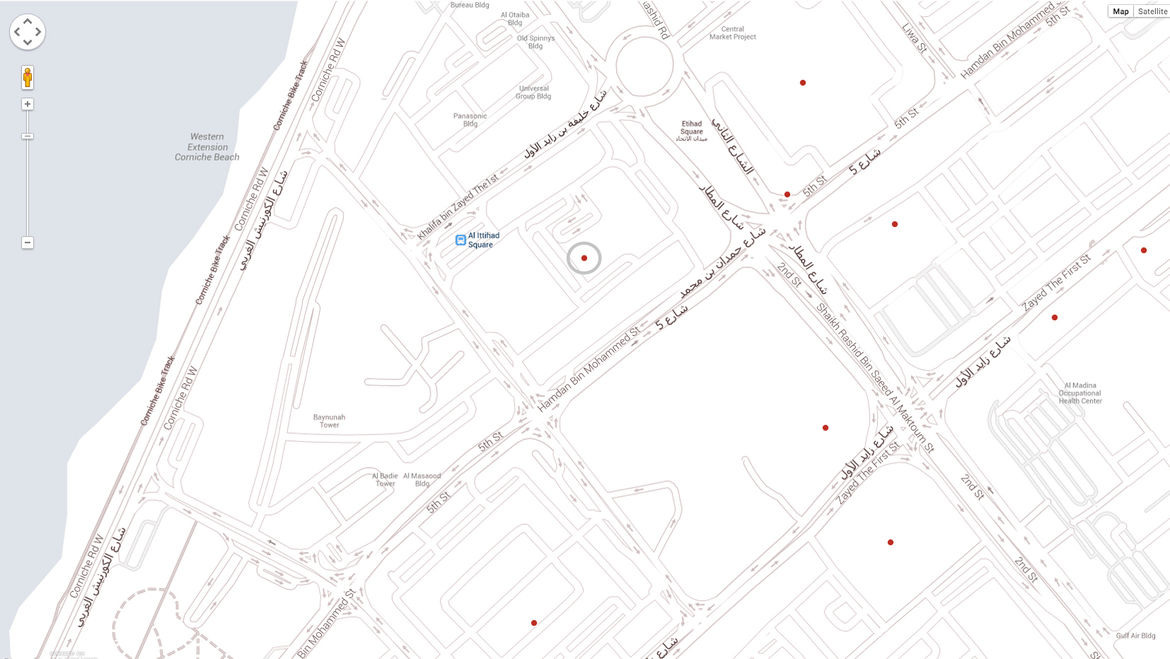2. Old Fish Market 1992-2005
Abad Al-Radi and Nazar Ahmad (Planar) with initial input from Skaarup and Jespersen (Denmark)
Al-Nasr Street across from the Cultural Foundation
Bus Routes 040, 063
Built in the center of town near the old Central Market, the Central Fruit, Vegetable, and Fish Market (now referred to as the Old Fish Market), was designed in 1988 and opened to the public in 1992. Its Iraqi architects, Abad Al-Radi and Nazar Ahmed, were awarded the project after winning a design competition. The market lived a short, thirteen-year life before being demolished in 2005. The official reason given by the Municipality for its destruction was its failure to meet hygiene standards. Speaking to former vendors, it seemed that the market might have also suffered from a lack of business.
The architecture of the Old Fish Market was praised locally and internationally for its ability to achieve a balance between modernism and regionalism. Yet today, recollections of this fleeting building are hard to spark in peoples’ memories. Only the hard fact of the building’s presence seems to remain. Unlike structures such as the Old Central Market, Volcano Fountain, and Qasr Al-Hosn, it seems the Old Fish Market has left less of an emotional imprint on the memories of those who knew it.
Nonetheless, its architecture made an impression while it lasted. The chief designers of the building sought to harmonize a modern style with regional inspirations. This attitude was part of larger efforts and anxieties in the UAE around ensuring that new buildings retained some sort of local rootedness. In this setting, Oriental – or Orientalist – motifs often became synonymous with the local. This attitude marked a shift from the 1960s and 1970s, when buildings were plainer and much less decorative than in the following decades.
In the case of the Old Fish Market, Sheikh Zayed requested domes to be incorporated into each atrium. Other Oriental motifs included a grand horseshoe arch alongside a promenade of smaller arches that formed entrances to the building. The overall layout and ordered repetition followed a geometric pattern, with the main market unit recurring twice geometrically, and the many entrances of the building convening under the two domed central atriums.
The designers of the Old Fish Market were wary of creating a building that would be considered a pastiche, and tried to acclimatize to the international modern style. The sparse geometric decoration of the building was both modern and regional. The slightly inflated structural outline of the Fish Market, clean but spherical at the edges, further extended the dialogue between the modern and the regional.
Photographs of the Old Fish Market reveal a building that looks as though it was in thoughtful conversation with itself, seeking to articulate the Emirati modern, while on the surface managing to appear seamless and noise-free. It was a building that did not overstate itself, and yet had much to say.
The interior of the building started a different conversation: the Old Fish Market was a contrived public space. Used by the public and yet owned by the municipality, it reflects subsequent attempts by the government to control informal activities. The two-story barrel-vaulted structure serviced 112 shopkeepers and bore a close resemblance to the still-standing Central Souq in Sharjah, which is featured on the five dirham bill. Sharjah’s Central Souq has a main interior, which, like the Fish Market, forms a two-story horseshoe-shaped enclosed main space lined with shops on either side.
The interior use of the Old Fish Market was problematic in the way it inconvenienced fruit and vegetable sellers. Since the first floor was used as a fish market, the fruit and vegetable vendors had to withstand the impracticalities of receiving larger deliveries on the second floor. This resulted in major ramp, service lifts, and escalator additions, so that the building could function with relative ease.
Besides hygiene and the desire to build an "odorless" market, which was achieved by the city in the subsequent 2009 and 2013 Fish Markets, other reasons for the market’s closure could have been the fact that it was situated on prime real estate. Before it was a Fish Market, the plot was a dilapidated market with a tin roof. Before this, the land was used as a police station with a small prison attached. After the market was demolished, New York University Abu Dhabi used the plot for its main campus. What will become of the plot when the university relocates its center remains unknown.
Needless to say, like many of the spaces in Abu Dhabi, this plot has seen its share of changes. However, the Old Fish Market was a recognized piece of architectural beauty that could easily have adapted its function. It could have been adapted into a university campus, which would have allowed it enough time to perhaps become iconic, or at least span the memory of more than one generation.

